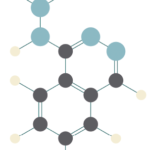Discussion
Hydralazine-induced ANCA-associated vasculitis is a rare complication of hydralazine therapy that cannot be missed. It can present with ANA, ANCA and anti-histone positivity, along with a pulmonary-renal syndrome that causes rapid clinical deterioration.6,7 Anti-cardiolipin and beta-2-glycoprotein IgM positivity have been reported, but these associations are not universal. Complement levels can be normal, but have been reported low in some cases.8 Systemic symptoms may or may not be present, and when present typically mirror those seen in hydralazine-induced lupus.
Our patient presented with a positive ANA, MPO- and PR3-ANCAs, anti-histone antibody, and lupus anticoagulant. He presented with hemoptysis and acute kidney injury. He was unique in his markedly elevated titers of both MPO- and PR3-ANCAs despite an overall lack of systemic symptoms.
In a previous case report, Agarwal et al. suggest that both MPO- and PR3-ANCA may play a role in this disease.9
Systematic vasculitis as a consequence of treatment with hydralazine is considerably rarer than hydralazine-induced lupus.
An extensive literature search yielded only two previously reported patients with hydralazine-induced ANCA-associated vasculitis who expressed significant PR3-ANCA positivity.10 PR3 titers were 52 units/mL (normal <20 units/mL) and 56 units/mL, compared with 167 units/mL in our patient. In the aforementioned two patients, MPO-ANCA was either weakly positive (23 units/mL) or negative. Our patient demonstrated marked positivity for both MPO- (100 units/mL, normal <20/mL) and PR3-ANCA (167 units/mL). We could not find such high titers of both MPO- and PR3-ANCA in any previously reported case of hydralazine-induced vasculitis.
Formal diagnostic criteria have not yet been published for hydralazine-induced vasculitis. In one study, Kumar et al. highlight the overlapping features of hydralazine-induced lupus and hydralazine-associated vasculitis. They suggest that hydralazine-associated autoimmunity exists on a continuum. Patients with hydralazine-induced vasculitis may possess some clinical and laboratory findings of drug induced-lupus. However, hydralazine-induced vasculitis is unique in its rapid progression and pulmonary and renal involvement. Laboratory findings differ; hydralazine-induced vasculitis is associated with ANCA positivity, in addition to a positive ANA and the presence of anti-histone antibodies. Anti-histone antibodies are not typically seen in ANCA-associated vasculitis that does not involve hydralazine. In most cases, ANCA positivity was predominantly due to antibodies against MPO.
Renal and pulmonary biopsies should be conducted when there is a suspicion for hydralazine-induced ANCA-associated vasculitis. The results of a renal biopsy aid greatly in diagnosing hydralazine-induced ANCA-associated vasculitis and differentiating this condition from hydralazine-induced lupus. Renal biopsy has revealed a pauci-immune glomerulonephritis in all patients with hydralazine-induced ANCA-associated vasculitis who have been biopsied, with or without evidence of focal small artery and arteriolar fibrinoid necrosis.11,12
Kumar et al. suggest these findings support the notion that hydralazine-induced ANCA-associated vasculitis is a process that is subacute or chronic, rather than acute. In hydralazine-induced lupus, on the contrary, renal biopsy demonstrates immune complex deposition. Without a renal biopsy, we technically cannot definitively rule out hydralazine-induced lupus in favor of hydralazine-induced vasculitis.
There was some consideration that our patient may have suffered from hydralazine-induced lupus, because this disease can be a cause of diffuse alveolar hemorrhage and hemolytic anemia. However, given the aggressiveness of our patient’s presentation in the form of diffuse alveolar hemorrhage and exacerbation of preexisting renal disease, coupled with highly elevated MPO- and PR3-ANCA titers, our suspicion was higher for vasculitis. Therefore, we felt confident in initiating treatment for hydralazine-induced ANCA-associated vasculitis without renal biopsy.
Although our patient lacked any clinical symptoms commonly associated with
hydralazine-induced lupus, such as arthralgias and cutaneous findings, we also acknowledge the possibility that our patient may have suffered from a combination of both hydralazine-induced lupus and hydralazine-induced ANCA-associated vasculitis.
Kumar et al. have presented the notion that patients with hydralazine-induced ANCA-associated vasculitis may simultaneously present with features of both drug-induced lupus and drug-induced vasculitis. In our patient, the only features commonly associated with hydralazine-induced lupus were a positive ANA, the presence of anti-histone antibodies and lupus anticoagulant positivity. These findings could also have been caused by long-term hydralazine use without concomitant hydralazine-induced lupus.
Transbronchial biopsy in hydralazine-induced ANCA-associated vasculitis may demonstrate pulmonary capillaritis, but it is not always performed. Gross hemoptysis is a less common symptom and may be indicative of more advanced disease. In mild disease, computed tomography (CT) scans of the chest typically reveal bilateral pulmonary infiltrates with or without pleural effusions. In severe cases, CT scans can show groundglass opacities concerning for diffuse alveolar hemorrhage.
Identified risk factors for hydralazine-induced ANCA-associated vasculitis include a cumulative dose of more than 100 g, longer duration of therapy, female sex, slow hepatic acetylation, the null gene for C4 and a history of thyroid disease.13,14
Hydralazine is known to cause autoimmunity. Several theories have been proposed addressing potential mechanisms by which hydralazine can induce ANCA-associated vasculitis. Accumulations of hydralazine in intracytoplasmic neutrophilic granules have been shown to bind to myeloperoxidase, which then causes apoptosis and the expulsion of intracellular material. Interaction between this material and antigen-presenting cells can cause the production of anti-neutrophil cytoplasmic antibodies and anti-nuclear antibodies.15
In a separate study, Magro et al. hypothesize that hydralazine interferes with neutrophil extracellular traps (NETs) and consequently enhances antigen exposure to antigen presenting cells.16
Others have hypothesized that hydralazine enhances the expression of neutrophil autoantigens by reversing the epigenetic silencing of MPO and PR3. It is also believed that slow acetylation of hydralazine and the resulting drug metabolites lead to the breakdown of central tolerance.17,18
Hydralazine-related drugs, such as dihydralazine and cadralazine, are known to cause drug-induced lupus; however, little information is present on their propensity to cause drug-induced ANCA-associated vasculitis. These drugs break down into metabolites that are known to inhibit myeloperoxidase activity.19 Therefore, one could reasonably assume that hydralazine-related drugs could potentially induce ANCA-associated vasculitis. However, more research would be needed to fully establish whether or not hydralazine-related drugs could be used as substitutes to potentially reduce or eliminate the risk of inducing ANCA-associated vasculitis.
When a diagnosis of hydralazine-induced ANCA-associated vasculitis is suspected, hydralazine, the disease-causing agent, should be promptly stopped due to the rapidly progressing nature of this disease. Timlin et al. have identified that hydralazine-induced ANCA-associated vasculitis may be associated with poor renal outcomes.20
A review of literature demonstrated no uniform therapy to treat hydralazine-induced ANCA-associated vasculitis. However, immunosuppressive regimens typically include a combination of both steroids and cytotoxic therapy. Treatments used have included methylprednisolone and prednisone for steroid therapy and cyclophosphamide or mycophenolate mofetil for cytotoxic therapy.
Our patient was treated with prednisone, cyclophosphamide and two pulses of methylprednisolone. Our patient also received a course of plasma exchange therapy. Plasma exchange was not uniformly performed in the patients that we reviewed and was generally reserved for more severe cases, if performed at all.
Prognosis is unclear in hydralazine-induced ANCA-associated vasculitis. Some patients underwent complete recovery, whereas others required immunosuppression indefinitely. The cause of these differences is likely multifactorial.
Our patient presented solely with hemoptysis and acute kidney injury. This patient may prove important in furthering our understanding of this rare but serious medication complication.
Our patient’s PR3-ANCA titer was highly elevated. This finding is consistent with the hypothesis by Agarwal et al. that PR3-ANCA, in addition to MPO-ANCA, may play a role in causing disease. Despite presenting without any of the common clinical symptoms of hydralazine-induced lupus, our patient also supports Kumar et al.’s recent presentation of the overlapping features between hydralazine-induced lupus and hydralazine-induced ANCA-associated vasculitis.
Caution should be exercised when prescribing hydralazine due to its potential to precipitate disease and the rapid deterioration associated with hydralazine-induced ANCA-associated vasculitis. Keasberry et al. suggest that it may be prudent to avoid using hydralazine in patients with a history of autoimmune disease and to regularly check the urine for red blood cells.21
When relevant, a kidney biopsy should be obtained, because a pauci-immune glomerulonephritis in the setting of long-term hydralazine use may be confirmatory when hydralazine-induced ANCA-associated vasculitis is suspected.
Further research is needed to fully understand the pathophysiology, risk factors and ideal treatment of this rare, but potentially deadly, complication of hydralazine use. Additional study may dictate whether or not it could be prudent to delay starting hydralazine in patients with or without heart failure due to its potential to cause serious autoimmune disease in the future.

